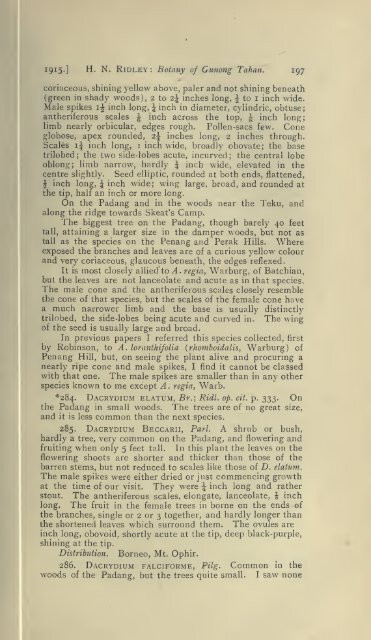Journal of the Federated Malay States museums - Sabrizain.org
Journal of the Federated Malay States museums - Sabrizain.org
Journal of the Federated Malay States museums - Sabrizain.org
Create successful ePaper yourself
Turn your PDF publications into a flip-book with our unique Google optimized e-Paper software.
|l<br />
I<br />
II<br />
It<br />
II<br />
H. N. Ridley: Botany <strong>of</strong> Gunong Tahan. 197<br />
coriaceous, shining yellow above, paler and not shining beneath<br />
(green in shady woods), 2 to 2 J inches long, J to i inch wide.<br />
Male spikes 1^ inch long, J inch in diameter, cylindric, obtuse;<br />
an<strong>the</strong>riferous scales ^ inch across <strong>the</strong> top, | inch long;<br />
limb nearly orbicular, edges rough. Pollen-sacs few. Cone<br />
globose, apex rounded, 2^ inches long, 2 inches through.<br />
Scales i^ inch long, i inch wide, broadly obovate; <strong>the</strong> base<br />
trilobed; <strong>the</strong> two side-lobes acute, incurved; <strong>the</strong> central lobe<br />
oblong; limb narrow, hardly ^ inch wide, elevated in <strong>the</strong><br />
centre slightly. Seed elliptic, rounded at both ends, flattened,<br />
^ inch long, ^ inch wide; wing large, broad, and rounded at<br />
<strong>the</strong> tip, half an inch or more long.<br />
On <strong>the</strong> Padang and in <strong>the</strong> woods near <strong>the</strong> Teku, and<br />
along <strong>the</strong> ridge towards Skeat's Camp.<br />
The biggest tree on <strong>the</strong> Padang, though barely 40 feet<br />
tall, attaining a larger size in <strong>the</strong> damper woods, but not as<br />
tall as <strong>the</strong> species on <strong>the</strong> Penang and Perak Hills. Where<br />
exposed <strong>the</strong> branches and leaves are <strong>of</strong> a curious yellow colour<br />
and very coriaceous, glaucous beneath, <strong>the</strong> edges reflexed.<br />
It is most closely allied to A. regia, Warburg, <strong>of</strong> Batchian,<br />
but <strong>the</strong> leaves are not lanceolate and acute as in that species.<br />
The male cone and <strong>the</strong> an<strong>the</strong>riferous scales closely resemble<br />
<strong>the</strong> cone <strong>of</strong> that species, but <strong>the</strong> scales <strong>of</strong> <strong>the</strong> female cone have<br />
a much narrower limb and <strong>the</strong> base is usually distinctly<br />
trilobed, <strong>the</strong> side-lobes being acute and curved in. The wing<br />
<strong>of</strong> <strong>the</strong> seed is usually large and broad.<br />
In previous papers I referred this species collected, first<br />
by Robinson, to A. loranthifolia (rhomboidalis, Warburg) <strong>of</strong><br />
Penang Hill, but, on seeing <strong>the</strong> plant alive and procuring a<br />
nearly ripe cone and male spikes, I find it cannot be classed<br />
with that one. The male spikes are smaller than in any o<strong>the</strong>r<br />
species known to me except A. regia, Warb.<br />
*284. Dacrydium elatum, Br.; Ridl. op. cit. p. 333. On<br />
<strong>the</strong> Padang in small woods. The trees are <strong>of</strong> no great size,<br />
and it is less common than <strong>the</strong> next species.<br />
285. Dacrydium Beccarii, Pari. A shrub or bush,<br />
hardly a tree, very common on <strong>the</strong> Padang, and flowering and<br />
fruiting when only 5 feet tall. In this plant <strong>the</strong> leaves on <strong>the</strong><br />
flowering shoots are shorter and thicker than those <strong>of</strong> <strong>the</strong><br />
barren stems, but not reduced to scales like those <strong>of</strong> D. elatum.<br />
The male spikes were ei<strong>the</strong>r dried or just commencing growth<br />
at <strong>the</strong> time <strong>of</strong> our visit. They were \ inch long and ra<strong>the</strong>r<br />
stout. The an<strong>the</strong>riferous scales, elongate, lanceolate, i inch<br />
long. The fruit in <strong>the</strong> female trees in borne on <strong>the</strong> ends <strong>of</strong><br />
<strong>the</strong> branches, single or 2 or 3 toge<strong>the</strong>r, and hardly longer than<br />
<strong>the</strong> shortened leaves which surround <strong>the</strong>m. The ovules are<br />
inch long, obovoid, shortly acute at <strong>the</strong> tip, deep black-purple,<br />
shining at <strong>the</strong> tip.<br />
Distribution. Borneo, Mt. Ophir.<br />
286. Dacrydium falciforme, Pilg- Common in <strong>the</strong><br />
woods <strong>of</strong> <strong>the</strong> Padang, but <strong>the</strong> trees quite small. I saw none

















